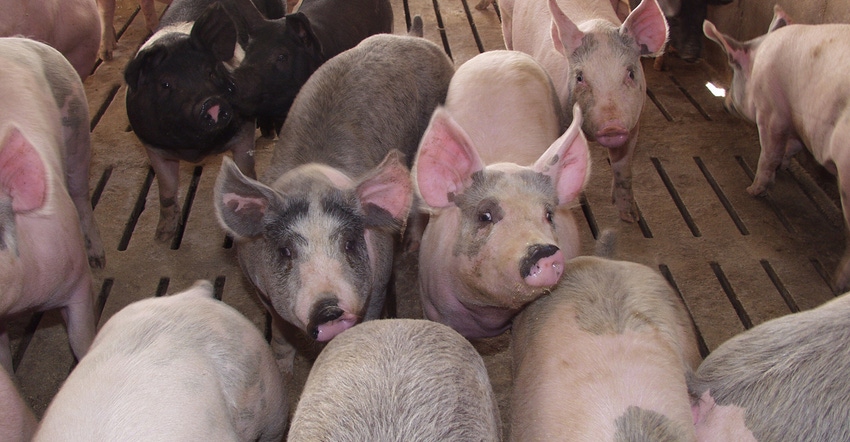Christensen Farms veterinarian says in her experience, lameness is the No. 1 cause of mortality in mid-to-late finishing stage pigs.
October 23, 2020

Lameness and arthritis management were the subject of a webinar sponsored by the Swine Health Information Center and American Association of Swine Veterinarians on Oct.13. Kathleen Wood, a veterinarian with Christensen Farms, says in her experience, lameness is the No. 1 cause of mortality in mid-to-late finishing stage pigs. Understanding the causes, costs and methods of managing can help address consequences of lameness and arthritis.
Wood was joined by nutritionist Paul Cline, Christensen Farms, practitioner Michael Eisenmenger, Swine Vet Center, and diagnosticians Michael Rahe, Iowa State University and Stephanie Rossow, University of Minnesota. The latest in a series of webinars addressing swine industry chatter, this event provided participants' experience, recommendations and direction for addressing these issues which have been on the rise, per submissions to veterinary diagnostic labs. The webinar was conducted by ISU's Swine Medicine Education Center.
Eisenmenger and Wood say solving the issue of lameness requires veterinarians to be in barns, observing animals, as well as performing necropsies to define the cause of lameness. Eisenmenger recommends combining resources to examine flow, health, nutrition and operations as causes of lameness and working together to identify issues. The best chance for success, he advises, is to work in a manner that increases the opportunity for answers when working with VDLs.
Wood says she had farms where 10 to 25% stiffness in grow-finish pigs grew to 25 to 40% this year. She attributes the increase to a variety of factors including infectious arthritis, injury or trauma, as well as leg conformation problems or defects. Additionally, she attributes some of the increase in incidence to increased awareness of stiffness after a return to closer observation as barn visits resumed after a lag due to the COVID-19 pandemic.
Wood says anti-inflammatory injectables are an important treatment, relieving pain and related issues. However, their use is variable and may be difficult to manage with potential issues revolving around withdrawal times for grow-finish pigs. She also recommends looking upstream for possible origin of stiffness/lameness problems including sow nutrition, sow farm medications and pre-farrow vaccinations.
Critical to management is field communication. Wood says continual training of staff to recognize and properly identify issues is essential, working from the premise lameness and stiffness are not part of "normal." She also recommends more practitioner field time, necropsies and pursuing diagnostics. In fact, she says, "necropsy everything," including popping open joints, snapping ribs and identifying broken bones during routine necropsies versus only in infection/abscess presence.
Wood's colleague, Cline, shared a nutritionist's perspective during the webinar. He says the industry needs to do better at understanding the interactions between health and nutrition. One of the ways to deal with that is to nurture the agreement that veterinarians and nutritionists are working toward the same goal. He also believes a more robust standard reference resource for bone characteristics is necessary.
Cline says the consequences of an out-of-feed event aren't truly understood in terms of how quickly bone ash changes. Another area in need of examination involves components that need to be measured to understand impact on bone. This includes boron levels in feed, impact of intake level on bone development, as well as seasonality.
For getting the best results when seeking results from submissions to VDLs, Rahe offers these best practices:
Submitters can call VDL ahead of time and discuss what is seen in impacted pigs and what tissues would be helpful to submit
Live pigs or limbs can be submitted
Tissues to submit for lameness workup
Evaluate joints to rule out infectious arthritis or submit limbs
Serum — Vitamin D (collect antemortem or shortly after euthanasia)
Second ribs — (bone ash and density)
Fixed long rib(s) — 10th ribs (microscopic evaluation of physis (growth plate) and trabecular and cortical bone)
Fixed skeletal muscle from hamstrings, triceps and diaphragm
Fresh and fixed liver (Vitamin E and trace mineral panel)
Urine (calcium and phosphorus)
Fresh and fixed lung, kidney, spleen, and brain to rule out systemic disease, meningitis, encephalitis, etc.
Rahe says acutely affected pigs are better than chronic pigs for sample submission and agent isolation. Sampled pigs should represent what is being observed in the herd. He also emphasizes that findings/diagnosis in one pig could be an isolated case and not necessarily representative of the herd. Correspondingly, the same finding in multiple animals then adds confidence in a herd level diagnosis.
Rossow emphasizes that structure of the pig is directly tied to function, so addressing lameness concerns is essential. She says abnormal structure equals abnormal function with related consequences affecting pig health and performance. Understanding of disease initiators versus promoters also helps develop effective prevention and treatment protocols. Rossow reiterates the importance of using a diagnostic lab, saying VDLs have the people, time and tools for extensive investigation.
As the world deals with the COVID-19 pandemic, SHIC continues to focus efforts on prevention, preparedness and response to novel and emerging swine disease for the benefit of U.S. swine health. SHIC is funded by America's pork producers to fulfill its mission to protect and enhance the health of the U.S. swine herd.
Source: Swine Health Information Center, which is solely responsible for the information provided, and wholly owns the information. Informa Business Media and all its subsidiaries are not responsible for any of the content contained in this information asset.
You May Also Like



